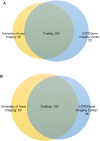Discordant Quantitative and Visual CT Assessments in the Diagnosis of Emphysema
- PMID: 33976544
- PMCID: PMC8106452
- DOI: 10.2147/COPD.S284477
Discordant Quantitative and Visual CT Assessments in the Diagnosis of Emphysema
Abstract
Purpose: Visual assessment of computed tomography (CT) of the lung is routinely employed in the diagnosis of emphysema. Quantitative CT (QCT) can complement visual CT but must be well validated. QCT emphysema is defined as ≥5% of lung volume occupied by low attenuation areas ≤-950 Hounsfield units (LAA-950). Discordant visual and QCT assessments are not uncommon. We examined the association between visual and quantitative chest CT evaluation within a large cohort of subjects to identify variables that may explain discordant visual and QCT findings.
Materials and methods: Volumetric inspiratory CT scans of 1221 subjects enrolled in phase 1 of the COPDGene study conducted at the University of Iowa were reviewed. Participants included never smokers, smokers with normal spirometry, preserved ratio impaired spirometry, and Global Initiative for Obstructive Lung Disease (GOLD) stages I-IV. CT scans were quantitatively scored and visually interpreted by both the COPDGene Imaging Center and the University of Iowa radiologists. Individual-level visual assessments were compared with QCT measurements. Agreement between the two sets of radiologists was calculated using kappa statistic. We assessed variables associated with discordant results using regression methods.
Results: There was a fair agreement for the presence or absence of emphysema between our center's radiologists and QCT (61% concordance, kappa 0.22 [0.17-0.28]). Similar comparisons showed a slight agreement between the COPDGene Imaging Center and QCT (56% concordance, kappa 0.16 [0.11-0.21]), and a moderate agreement between both sets of visual assessments (80% concordance, kappa 0.60 [0.54-0.65]). Current smoking and female gender were significantly associated with QCT-negative but visually detectable emphysema.
Conclusion: The slight-to-fair agreement between visual and quantitative CT assessment of emphysema highlights the need to utilize both modalities for a comprehensive radiologic evaluation. Discordant results may be attributable to one or more factors that warrant further exploration in larger studies.
Clinical trial registration: ClinicalTrials.gov Identifier NCT000608764.
Trial registration: ClinicalTrials.gov NCT00608764 NCT00608764.
Keywords: Akaike information criterion; chest imaging; chronic obstructive pulmonary disease; interobserver agreement.
© 2021 Amaza et al.
Conflict of interest statement
Dr Spyridon Fortis reports grants from the American Thoracic Society and Fisher Paykel, outside the submitted work; and is a Consultant for Genentech. Dr Alejandro P Comellas reports grants from the National Institutes of Health, non-financial support from VIDA, during the conduct of the study; personal fees from GlaxoSmithKline, outside the submitted work. The authors report no other conflicts of interest in this work.
Figures





Similar articles
-
A combined pulmonary-radiology workshop for visual evaluation of COPD: study design, chest CT findings and concordance with quantitative evaluation.COPD. 2012 Apr;9(2):151-9. doi: 10.3109/15412555.2012.654923. Epub 2012 Mar 19. COPD. 2012. PMID: 22429093 Free PMC article.
-
Relationships between airflow obstruction and quantitative CT measurements of emphysema, air trapping, and airways in subjects with and without chronic obstructive pulmonary disease.AJR Am J Roentgenol. 2013 Sep;201(3):W460-70. doi: 10.2214/AJR.12.10102. AJR Am J Roentgenol. 2013. PMID: 23971478 Free PMC article.
-
Quantitative computed tomography measurements to evaluate airway disease in chronic obstructive pulmonary disease: Relationship to physiological measurements, clinical index and visual assessment of airway disease.Eur J Radiol. 2016 Nov;85(11):2144-2151. doi: 10.1016/j.ejrad.2016.09.010. Epub 2016 Sep 13. Eur J Radiol. 2016. PMID: 27776670 Free PMC article. Review.
-
Relationships between diffusing capacity for carbon monoxide (DLCO), and quantitative computed tomography measurements and visual assessment for chronic obstructive pulmonary disease.Eur J Radiol. 2015 May;84(5):980-5. doi: 10.1016/j.ejrad.2015.01.010. Epub 2015 Jan 22. Eur J Radiol. 2015. PMID: 25704753
-
Establishing normal reference values in quantitative computed tomography of emphysema.J Thorac Imaging. 2013 Sep;28(5):280-3. doi: 10.1097/RTI.0b013e3182a0d805. J Thorac Imaging. 2013. PMID: 23966092 Free PMC article. Review.
Cited by
-
Early Diagnosis of High-Risk Chronic Obstructive Pulmonary Disease Based on Quantitative High-Resolution Computed Tomography Measurements.Int J Chron Obstruct Pulmon Dis. 2023 Dec 27;18:3099-3114. doi: 10.2147/COPD.S436803. eCollection 2023. Int J Chron Obstruct Pulmon Dis. 2023. PMID: 38162987 Free PMC article.
-
Differentiating Emphysema From Emphysema-Dominated COPD Patients with CT Imaging Feature and Machine Learning.Int J Chron Obstruct Pulmon Dis. 2025 Jul 25;20:2615-2628. doi: 10.2147/COPD.S527914. eCollection 2025. Int J Chron Obstruct Pulmon Dis. 2025. PMID: 40734725 Free PMC article.
-
Quantitative CT at Follow-Up of COVID-19 Pneumonia: Relationship with Pulmonary Function Tests.Diagnostics (Basel). 2023 Oct 27;13(21):3328. doi: 10.3390/diagnostics13213328. Diagnostics (Basel). 2023. PMID: 37958224 Free PMC article.
-
Non-cancerous CT findings as predictors of survival outcome in advanced non-small cell lung cancer patients treated with first-generation EGFR-TKIs.PLoS One. 2025 Feb 5;20(2):e0313577. doi: 10.1371/journal.pone.0313577. eCollection 2025. PLoS One. 2025. PMID: 39908320 Free PMC article.
-
When Treatment of Pulmonary Emphysema with Endobronchial Valves Did Not Work: Evaluation of Quantitative CT Analysis and Pulmonary Function Tests Before and After Valve Explantation.Int J Chron Obstruct Pulmon Dis. 2022 Oct 11;17:2553-2566. doi: 10.2147/COPD.S367667. eCollection 2022. Int J Chron Obstruct Pulmon Dis. 2022. PMID: 36304970 Free PMC article.
References
-
- COPDGene. Clinical center manual of procedures. Version 5.0; 2009. Available from: www.copdgene.org/sites/default/files/COPDGene%20MOP%2006.19.2009.pdf. Accessed February11, 2021.
Publication types
MeSH terms
Associated data
Grants and funding
LinkOut - more resources
Full Text Sources
Medical

